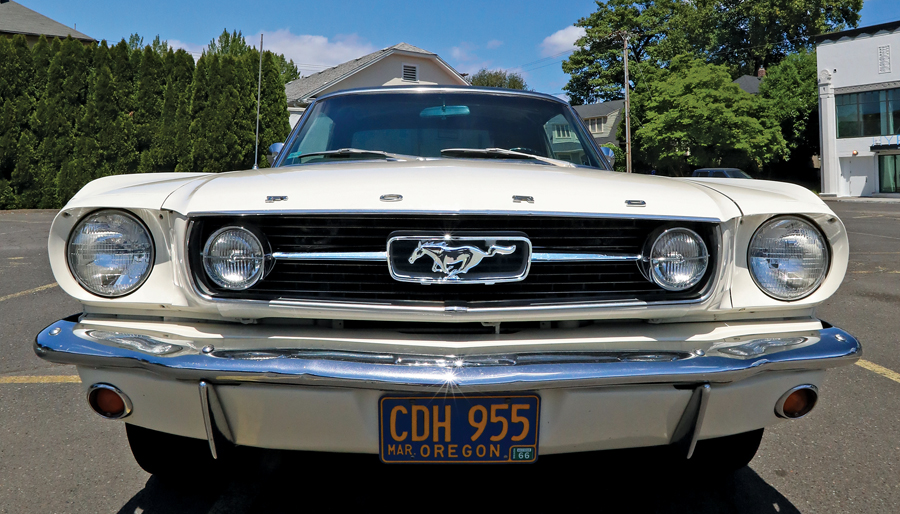
When it comes to bang for your buck — or purchasing your first classic car — the 1964½ through 1966 Ford Mustang should be on your radar.
No other car on the planet is so universally recognized — and not just in the United States. You’ll see Mustangs on the road in the U.K., France, Germany and all over South America.
They’re bought and sold like popcorn at the movie theater, and you could probably build one from scratch — including the body — using a catalog and the Web as your only sources.
Ford launched the Mustang on April 17, 1964 (hence 1964½, although Ford has always referred to them as 1965s), as a coupe or convertible. The fastback came soon after, giving buyers three body styles to choose from.
Ford sold the hell out of them. From 1964½ through 1966, the end of the first-generation Mustang, Ford sold a total of 1,288,557 cars (Shelbys excluded).
That’s a lot of first-gen Mustangs.
Not rare — but still in demand
Given that sky-high build number, Mustangs are anything but rare, especially the coupes. But that lack of rarity means there are tons of them for sale — from project cars to minty-fresh restorations.
Just for fun, a quick look at Hemmings showed 380 1964½–66 Mustangs up for grabs. That total included all the body styles.
Locally, just on Craigslist in my area, I found a dozen or so in various conditions.
The bottom line is they are easy to locate and you probably won’t need to drive cross-country to find one that fits your budget. On top of that, just about any regional classic-car auction will have one or more for sale — and you might even score a bargain.
What you’ll pay
From a value overview, the coupes chime in with the lowest starting price. Expect to pay $17k–$27k for a V8 coupe in nice condition. The median value in the SCM Pocket Price Guide is $18,500. You should be able to dive down deeper than that if it’s an inline 6-cylinder example.
Stepping up to the convertible or fastback, expect to part with about $22k–$42k for a convertible and $35k–$45k for a V8 fastback. For any of these with the Ford 6-banger under the hood, the values can drop dramatically.
The high-performance K-code cars are pretty rare, so those cars will sell for substantially more. A K-code Mustang has the 271-horsepower “Hi-Po” 289-ci V8 engine and a special handling package.
Start with a coupe
Given the scope of this article, let’s focus on the humble coupes, as they are the most affordable of the bunch. Coupes account for about half the cars sold up through the 1966 model year. As discussed, they are super easy to find.
But we need to dissect the market a bit more cautiously.
If it were up to me — and I guess it is, as I’m writing this, I’d pass on any of the 6-cylinder cars unless you simply don’t care about having some grunt under the hood. Don’t misinterpret that; the 6-cylinder is a fantastic engine and incredibly easy to work on, but when it comes to selling your car, it will cut your buyer pool dramatically.
That said, a 6-cylinder example is your most affordable choice — by far.
Like most classic cars, the more pure and original the car is, the more it will generally sell for, depending on the condition. At the top of the tier are the K-codes in GT trim. These are basically affordable Shelby Mustangs without the upgrades — but also without the six-figure price tag. K-code coupes are a bit hard to find and can be pricey, but they are worthy of your search.
Dropping down the coupe ladder, your next-best option will be the A-code 4-bbl carburetor 289 examples. The early cars (1964½s) use different engine codes and started with 260-ci V8s under the hood, so keep that in mind. From there, and without question, the most plentiful examples will be C-codes, which mark the transition to the 2-bbl-carburetor 289 V8.
Options will add value as well, such as those in GT trim, Pony interiors and 4-speed transmissions. Air conditioning was an awkward add-on back when the cars were new, so I’d recommend adding a modern vintage air system rather than paying more for an original air car.
Why we love them
There are a lot of great reasons, beyond the fact that the cars can be affordable, to love an early Mustang.
Number one on my list is that they are robust cars and simple to work on. They are very pragmatic collector cars.
These days, every part on the car is reproduced, from OEM quality to pretty cheap sub-standard parts. You can customize the cars easily, and upgrades are a click away online. Buyer pools are plentiful and you might even discover that your kids think it’s a cool car.
Some owners, especially those who drive their Mustangs a lot, install disc brakes. Pay attention to the shocks and springs. Old shocks really degrade the driving experience.
These cars are also fun to drive. A V8 Mustang is nimble and makes nice sounds.
Ford sold over a million first-gen Mustangs — and for good reason. They were stylish, affordable, reliable and pretty cool cars — and they still are today. Have you driven a vintage Ford Mustang… lately? ♦